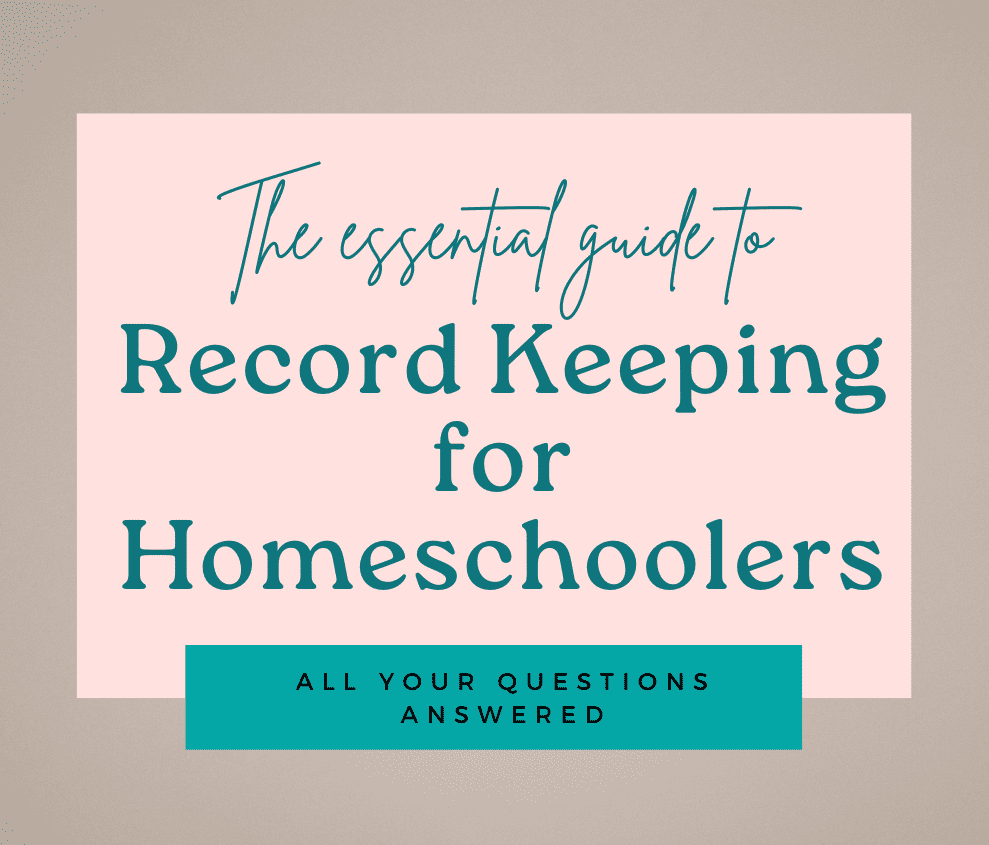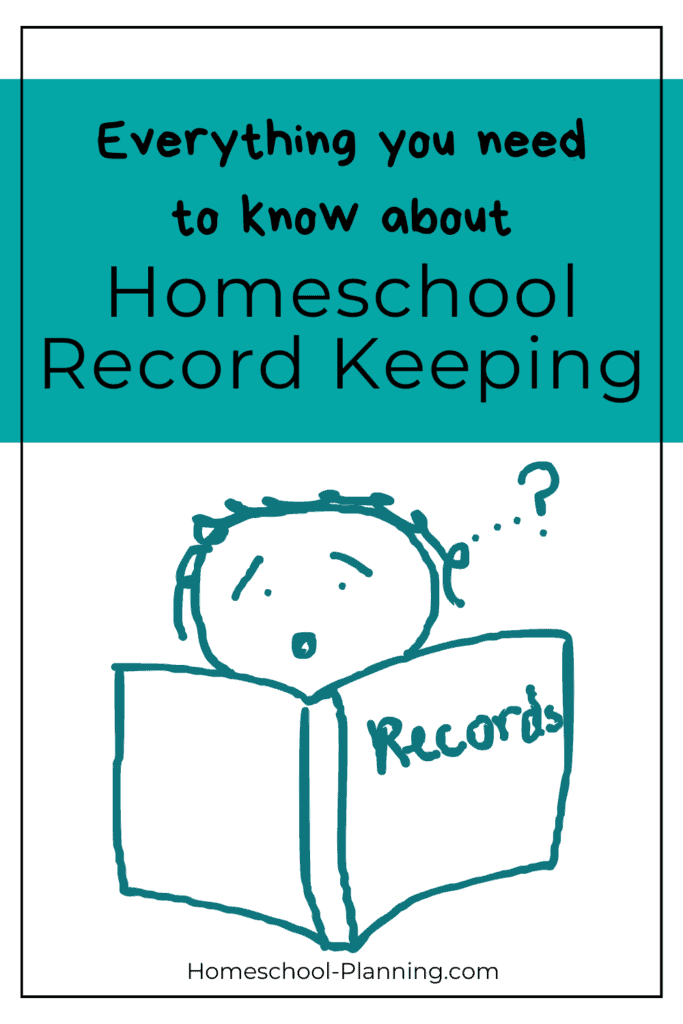One of the daunting parts of homeschooling your kids is learning about record keeping for homeschool. Do you need to keep every scrap of thing you do? And what you do keep, how do you store it, and for how long? What is even important enough to keep?
All these questions and more have been answered in this post. So if you have any questions about keeping records in your homeschool, then keep reading!

Why homeschool record keeping is important
It is important to keep homeschool records not only for personal reasons, but also to protect and prove your homeschooling efforts if challenged. Many US states require homeschool record keeping, but they also will be helpful if you decide to put your kids into traditional schools in the future or use any public school services.
Here are some specific reasons to keep good homeschool records:
- You may want them to look back on to remember what was covered.
- You may want to reference them when planning school for other children.
- It may be required by law in your state.
- You may need them for proof of homeschooling, if challenged.
- You may need them if you put your kids in a traditional school program.
- You may need records to participate in public school services, like speech therapy or athletics programs.
- You may need records to reinforce your transcript, especially for a high schooler.
- You may need them to apply for colleges or scholarships.
What homeschool records should you keep?
There are some basic homeschool records that every family should keep. These include samples of work, attendance, subjects/courses taught, grades, and test scores. Beyond these basic records, many US states will have additional requirements for homeschool families, so it is important to check the unique homeschool laws of your state.
Read: Planning, Tracking, and Record-Keeping: What’s the Difference?
These laws can be found through your state’s Department of Education or local homeschool association. You can also find a summary on the website of the Homeschool Legal Defense Association (HSLDA).
Here are the basic records every homeschool family should keep:
- Basic attendance (days and/or hours)
- Subjects taught
- Curriculum/resources used, if any
- Samples of work from beginning, middle, and end of year
- Grades received, if any
- List of books read
- Anything required by the state
Other homeschool records to consider keeping:
- Copies of documents turned in to the state
- Standardized test scores
- Extracurricular activities list (ie. clubs, sports, music)
- Records from previous schools attended
- Report Cards
- Any correspondence with school (or state) officials
- Immunization records
- Awards, certificates, and acheivements
- Credit planning for high school
- Table of contents from curriculum used
- Volunteer work
- List/description of what was learned in each subject or year
- Documentation of learning challenges or disabilities
- Records from coops or tutorials attended
- Transcript (high school)
- Course descriptions (high school)
- Dual enrollment records (high school)

When should I do my record keeping for homeschool?
It can be easiest to keep up with your record keeping if you track things throughout the school year. This way you won’t have to scramble to gather everything at the end of the year. Some states also require reporting of your homeschool records during the school year at certain points, so keeping up with them as you go will make these reports easy to submit when they are due.
You may like to track everything at the end of each school day or track several days in one go at the end of each week.
Many online curricula will keep records for you, making your reporting super easy. If this is the case, you will only need to download those records to keep them. Be sure to add info for any additional work you do outside of those classes as well.
How long should I keep homeschool records?
Many homeschool experts recommend keeping your basic homeschool records for at least 2-3 years. Though many families will keep records until their children graduate. Be sure to take note of your state’s requirements for keeping records as well, as some states ask that you keep records for a certain period of time.
For high school transcripts, it is recommended you keep this information indefinitely, or at least until college graduation. Occasionally you may need to present a high school transcript or portfolio at some point later in life.
How do I keep track of my homeschool progress?
Homeschool progress can be tracked in various ways. Many families do this by showing the progression of abilities through samples of homeschool work, keeping a sample of each subject from the beginning, middle, and end of the year. Another way to track progress is to keep records of grades and standardized tests. In a general sense, keeping records that the student progresses through levels of increased difficulty in their curriculum will also show progress (level 1, level 2, etc.).
It is rare that a student will need to prove homeschool progress, and is more likely that if progress is challenged, the school or authority may test your child to demonstrate skill abilities and grade level. However, keeping good records of progress in various forms may help prevent further questions in many cases.
How do you keep homeschool attendance records?
Keeping homeschool attendance records is fairly easy. Many homeschoolers will use a chart or basic calendar where they simply mark each day they did school. If your state requires tracking hours as well as days, a spreadsheet or hour tracking app may work well. At the end of the year, just add up the days/hours, and create your total for the year.
For more info on the specifics of tracking the days and hours in your homeschool, check out my post about homeschool attendance records here. And be sure to grab my free attendance tracking sheets.
If you want tips to plan out your homeschool attendance, then check out this post with step-by-step instructions and free printable attendance sheets to keep it all nice and easy!

How to document homeschool work
There are several ways to document homeschool work but overall, just be sure there is a tangible way to prove work has been completed by your child. This can be done by simply writing down what you cover each day and keeping samples of work. You can keep physical copies of these or take pictures and store them digitally. Better yet, do both for backup!
Many homeschoolers use homeschool planners to document what their kids do each day. You could also plan out what you want to do in advance and check it off as you go.
Read: Top 23 Homeschool Planners
Another way to document homeschool work is to take a spiral notebook and just write down what your child accomplishes. Simple. Or even place the date at the top of the pages your child does each day or week.
However you decide to document the work, the important part is that you have the documentation to back up what you say. It doesn’t have to be fancy, just finished!
And of course you don’t need to keep every piece of paper completed throughout the year! It is often recommended to keep a few samples of each subject from the beginning, the middle, and the end of the year. Keeping bigger projects, papers, and tests may also be good. And be sure to keep a couple of the real cute pictures and stories throughout the years just for funsies!
If you hate to have lots of paper around, keep in mind that you don’t have to keep these records as physical records. Digitally works great as well! You can use an online homeschool planner, or just take a picture of pages occasionally and store them on a hard drive or online.
For great options on homeschool planners check out my post on digital homeschool planners. Or if you prefer a physical version, look at my list of the top paper planners for homeschoolers.
What should be included in a homeschool report card?
A report card typically includes the student’s name, the subjects they have been studying, and a grade for each with credits also listed for high schoolers. Homeschoolers will often include the same things on a report card, though your state laws may have additional requirements.
Of course, if your state does not require any of this to be kept or turned in, a homeschool report card can be anything you like. You don’t even have to create one. However, it is still good to keep basic records of the classes covered each year and the curriculum used. Some parents also prefer to write a narrative description of the progress their child made on the subject each year rather than giving a grade.
High school homeschool students will also need this basic information included on their transcript.
What is a homeschool portfolio?
A homeschool portfolio has multiple definitions depending on who you ask. The portfolio can range from being something like an artist’s portfolio to a document similar to a resume. Often a 3-ring binder is used like an artist’s portfolio with samples of all the child’s best work, achievements, and other homeschool records included. The resume-like portfolio includes mostly extra-curricular achievements and is often created to accompany the high school transcript.
Some homeschoolers may create a homeschool portfolio that is kept with all the basic homeschool records, plans, lists, and samples of work. This can help you stay organized as you go through the year and make any strict reporting to the state easy. For parents who really like to organize and make things pretty this sort of portfolio may appeal to you. Think of it like an artist’s portfolio. All the best work and awards are included, as well as anything else that is relevant.
For high schoolers, occasionally a school or university may request additional information from your child about their high school achievements. This portfolio would be only 1-2 pages and will present anything that will make your child look desirable beyond normal academic achievements. Things like club participation, awards, and volunteer service. It may also include course descriptions and book lists.

How do I organize my homeschool stuff?
Many find it helpful to use general categories when organizing your homeschool stuff. For homeschool records, you may organize things by the year and the child. Beyond that, you may separate things into smaller sections as well, like legal documents, plans, work samples, and book lists. These can be kept in folders, binders, or just a general pile.
Read: Homeschooling Organization Tips for the Unorganized
At the end of the year, you can cull these down to what you feel is most important, removing excess papers.
Then you will keep these papers in some sort of long-term storage for the future. Many will just transfer their binder, planner, or loose pile to a plastic tote and store it. No need to overcomplicate it!
For help on organizing your child’s homeschool work, check out this post on organizing daily homeschool work.
How do you store homeschool records?
Storing homeschool records can be as simple as storing them in a tote or as organized as spreadsheets or a 3-ring binder portfolio. It all works! I just suggest you at least try to keep things divided somehow by the year, and maybe even the child, for future reference.
- A simple spiral notebook – Keep simple lists written in a blank notebook.
- Three-ring binders – Include samples of work and all resources used, cleanly organized behind dividers.
- Accordion folders – Include samples of work, resources used, and all the lists organized into file sections.
- Online photo storage – Take pictures of everything completed and used, and file them away in an online system.
- Homeschool planners – Use from day to day then file it away with samples of work at the end of the year.
- Apps – Many apps and websites are designed for homeschool record-keeping and planning.
- Spreadsheets – Store all your lists and records in a simple electronic spreadsheet.
- File box – Keep all your records filed by year and/or child in a file box.
- Storage tote – For those less organized pilers, storing records can be as simple as putting everything in a small storage tote.
Where do you store homeschool records?
Storing homeschool records can be done in a variety of places, from storage totes, to file boxes, to computer spreadsheets, to apps, to online picture storage. In whatever form you choose to keep these records, there is a place to store them. Just be sure for important documents like transcripts that you keep backup copies.
What is the best homeschool record keeping app?
There are several great options for online record-keeping. Some are made mostly to store records and generate transcripts, while others have more robust planning capabilities as well. I have listed these separately for you below.
Apps designed for homeschool record-keeping:
- Academicrecords.net by Classical Conversations
- Applecore
- FastTranscript
- Homeschool Hall
- Homeschool Reporting Online
- Modify
- My School Year
Apps with record keeping and planning capabilities:

What should I keep for high school homeschool records?
It is good to keep records of the various courses, books, and accomplishments your child completed during their high school years. This information is sometimes used for college applications as well as scholarship applications. These records should be kept from the time they begin completing high school-level work, sometimes as early as grade 7.
- Samples of work
- Attendance records
- Course descriptions (or the information to create them)
- List of curriculum used
- Subjects covered
- Report cards
- Transcripts from other schools
- Records from other schools
- Test scores
- List of books read
- Awards and honors received
- List of activities they participated in (clubs, sports, competitions)
- Work and volunteer experience
- Anything else required by your state
What should be included on a high school transcript?
A high school transcript is a document that gives a brief overview of your child’s academics throughout high school. It should be a simple one-page document with a list of courses taken, test scores, and GPA. While it’s easy to want to set your child apart from others with this document, this is not the place to do it, let the transcript speak for itself. Keep it simple and straightforward!
- Title of document: “High School Transcript”
- Student’s basic information (name, address, phone number, birth date)
- Homeschool name, and parent’s names, if desired
- Date of graduation (or expected date of graduation)
- A list of courses taken with the grade achieved and credit earned
- Courses can be listed by school year, grade level, or general subjects (math, science, arts)
- Note which courses were completed at previous schools or through dual enrollment
- Include the grading scale used
- The cumulative grade point average (GPA)
- College entrance exam scores (ACT, SAT)
- Signature of parent
What is the best transcript service for high school?
While many homeschoolers prepare their transcript themselves, it is often helpful to use a service. There are several services designed for creating homeschool transcripts, and I have included them below. While many homeschool record-keeping apps will create a basic transcript you can edit, these services offer more than basic, many of them offering great support and options to ensure the transcript is fabulous.
Here are the best options for specialized homeschool transcript services:
- FastTranscripts
- HSLDA’s Transcript Service
- Transcript Maker
- My Homeschool Transcripts
- Homeschool Hall Transcript Builder
Homeschool record keeping template
Homeschool record-keeping doesn’t have to be difficult or overwhelming. With these simple and straight-forward templates, worrying about keeping solid homeschool records will be a thing of the past. Download your set of free homeschool record-keeping printable today!
- 8 free templates
- Get organized
- List your legal requirements
- Create an annual progress report
- Record extra-curricular activities
- Mark your attendance
- Track student’s grades
- Keep a booklist
- 2 styles of annual reports (chart, narrative)
For other options and layouts for attendance tracking, download my set of free attendance trackers. This set includes layouts in calendar or chart form, with January or July start dates, and even includes hour trackers. Get your free download through this link.
Record keeping for homeschool
Record keeping for homeschoolers is not only a legal requirement in many states, but also a great way to track progress. By following the tips shared in this post, you can gain confidence in your record-keeping and ensure you’re meeting the necessary requirements. Whether you prefer digital apps or a traditional approach, staying organized along the way is key. And with the free template in this post, you’re ready to start your homeschool record-keeping with ease.
How do you keep your homeschool records? Share your unique approach in the comments!




